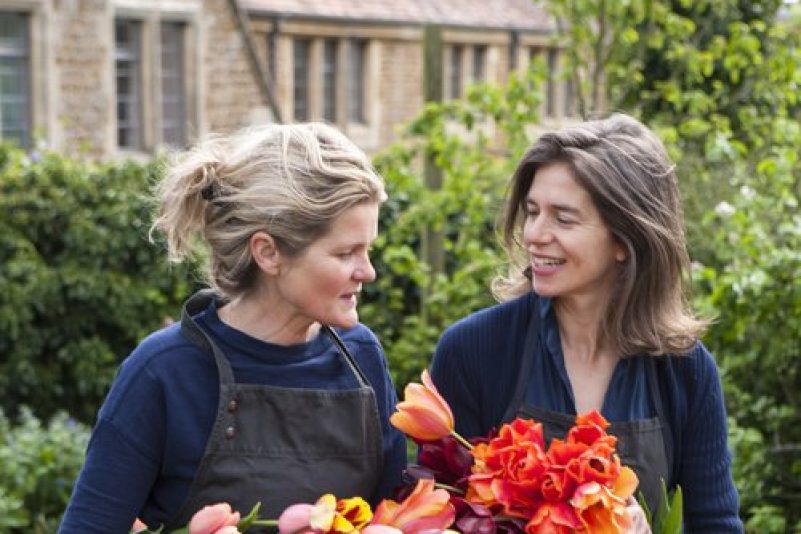Ten Things We Learned About Bringing Soil to the Public with Bridget Elworthy and Henrietta Courtauld

This conversation is the eighth instalment in our Talking Heads series with the LUNZ Hub Soil Health and Carbon Dynamics TAG community. In this series, we explore the diverse ways in which soil connects to climate, culture, and community — and the creative, scientific and policy responses emerging across the UK and beyond.
In this edition, TAG co-leads Ellen Fay (Sustainable Soils Alliance) and Professor Pete Smith (University of Aberdeen) speak with Bridget Elworthy and Henrietta Courtauld, co-founders of The Land Gardeners and co-curators of the SOIL: The World at Our Feet Exhibition, which opened to critical acclaim at Somerset House in early 2024. What began as a small organic flower enterprise grew into an international movement for soil awareness — culminating in a cultural exhibition that blends science, art, emotion and activism.
This article provides a summary of the key takeaways from the interview. The full interview can be viewed on the LUNZ YouTube channel.
1. The exhibition was born from a deep-rooted love of soil — and a desire to elevate it
Bridget and Henrietta’s journey began with compost. Their flower business in Oxfordshire doubled as a laboratory for restoring degraded soils using humified compost. When their Albrecht tests showed an increase in soil organic matter from 5% to over 12% – levels rarely seen in the UK – they were asked how they had done it. Their work evolved from hands-on trials to writing Soil to Table, a visually rich book introducing soil’s role in health, food and climate.
From the beginning, people were attracted to the flowers, but Bridget and Henrietta only ever wanted to talk about soil. After publishing Soil to Table, they saw the power of presenting soil beautifully. They approached Somerset House with a vision to show soil in a way that was revered — even saying they wanted to “raise soil to the couture levels”. They curated the Soil: The World at Our Feet exhibition with Claire Catterall and May Rosenthal Sloan, all bringing different angles, but for the Land Gardeners, the aim was clear: “to show the wonder of soil”.
2. The exhibition sought to offer hope and make soil feel relevant and alive
The exhibition was designed to leave people feeling uplifted and empowered. Soil was presented not as a problem, but as a living solution — one that plays an essential role in climate regulation through everyday biological processes. The curators also wanted visitors to recognise that they could support soil health indirectly, by choosing food, fibres, and materials that come from systems which nurture the soil.
A central message of the exhibition was that soil is not inert — it’s alive and deserves care. Bridget described it as helping people realise they have “a lot of little pets” in a pot of soil, and that those creatures depend on us for kindness. Bridget and Henrietta were also clear that it couldn’t be just about soil, it needed to reflect everything soil touches — the organisms below ground and the life above it.
3. Bridget and Henrietta were shocked to learn plastic has become part of our geology
Despite decades of working with soil, the curation process brought new and sometimes shocking discoveries. One of the most disturbing was the realisation that plastic has now become part of our soil’s geology. In one exhibit, artist Maeve Brennan documented how plastic-laden floodwaters in Burkina Faso had rendered entire fields unproductive, with livestock dying amid the waste.
More chilling still: fragments of plastic have been found embedded in Roman-era soil strata. This implies that plastics are no longer just pollutants — they are entering the permanent geological record. The exhibition brought this reality to life through powerful imagery, offering a sobering counterpoint to the show’s more hopeful elements.
4. Visitors responded with enthusiasm and emotion
One of the most rewarding outcomes for the curators was the overwhelming public response. The exhibition has strong links with schools, and children in particular were enchanted by the artwork — many for the first time engaging with the idea that soil is alive. Teachers helped to gather illustrated poems from schoolchildren across the country, which were compiled into a celebratory piece by poet Laura Mucha.
One immersive display proved particularly captivating for young audiences. This standout installation allowed visitors to walk through a simulated soil core, surrounded by time-lapse footage of protozoa, fungi and bacteria. The school children and their teachers were often visibly moved, seeing the science they’d discussed come to life vividly. Bridget and Henrietta have been collaborating with a teacher to create a campaign for the inclusion of soil education in the national curriculum — a legacy the curators fully support.
5. The exhibition’s key points will live beyond the Somerset House show
Bridget and Henrietta were clear that the exhibition was never intended to be a one-off. From the outset, they saw it as a springboard to wider education, policy influence and global collaboration, a vision which is now starting to take shape.
Several follow-on opportunities established through the exhibition are in development — including school engagement packages, touring versions of the show, and international partnerships. The exhibition’s World Map of Hope, a revolving globe highlighting inspiring soil initiatives, will continue to be added to and may be exhibited at future soil events and conferences. These efforts are designed to create a living, evolving global network.
6. Bridget and Henrietta hope to bring the exhibition beyond London
While the exhibition at Somerset House has drawn impressive footfall – over 45,000 people visited the show – Bridget and Henrietta noted that London is not accessible to everyone. They hope to take elements of the exhibition to rural communities, especially farmers and growers.
Bridget and Henrietta dream of a touring version that pairs digital content with locally relevant art, highlighting regional soil stories. They also see opportunities to collaborate with agricultural organisations to bring soil-centred cultural work directly onto farms and into communities.
7. A space for school children, farmers, and soil campaigners to come together
The exhibition drew a wide range of influential figures, even including His Majesty the King! Soil Association CEO Helen Browning OBE also visited, as did author and no-dig gardening advocate Charles Dowding, and National Trust Head of Gardens Sheila Das. For many, it was the first time they had seen their life’s work honoured in an artistic and public space.
There was also a quietly powerful moment when fifty farmers arrived on the same day as the King. Bridget and Henrietta, watching a stream of tweed jackets pass under the Somerset House arch, knew they had achieved something special — soil had drawn together people from many different walks of life.
8. There were ideas that didn’t make it into this exhibition, but Bridget and Henrietta already have plans for the next show
One concept that Bridget and Henrietta were especially eager to explore further was soil and energy. While some of these ideas made it into the films, there wasn’t room to fully unpack them in this exhibition. They’re already imagining a follow-up show that delves deeper into these themes. Their original vision included a three-part structure: below-ground, above-ground, and “beyond” (celestial or energetic influences). While that final section was scaled back, it remains a source of fascination — and could provide the basis for future creative work.
9. The goal isn’t just awareness — it’s policy, practice, and protection
Bridget and Henrietta are unequivocal: the exhibition was about more than awareness. They want to see a change in policy and practice. That includes phasing out harmful agricultural chemicals, offering a fair price for farmers, and improving consumer information.
They envision a future in which soils are protected like listed buildings — especially historic soils. They also advocate for investment in upstream solutions: healthy soil can reduce flooding, improve water quality, and lower hospital costs by improving food nutrition. Soil is not a niche interest — it is foundational to society’s resilience.
10. Beauty and science must work together
Asked what lessons they’d offer to the LUNZ Hub, Bridget and Henrietta were clear: we must combine rigour with emotion. Beauty can open the door — and science can guide the way through it. As they put it, “People come in for the flowers or the art, and then you sock them with the strong messages.”
Bridget and Henrietta see great potential in cross-sector collaboration — from research institutes to farmers’ groups to creative studios. The more we align efforts, share platforms, and speak with a unified voice, the more likely we are to inspire meaningful, lasting change.

Ellen Fay
Soil Health and Carbon Dynamics

Professor Pete Smith
Soil Health and Carbon Dynamics
Subscribe to our Newsletter
A quarterly update of all LUNZ Hub activities, events and news stories.
